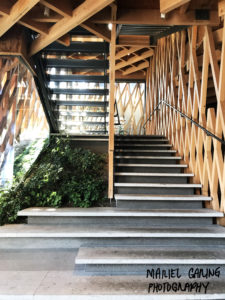5 Things Japanese Architects Did Right that We can Do Too

NOTE: Architect Mariethel Garing was recently in Tokyo, Japan for pleasure. She mixed business with pleasure as she observed Japanese architecture in order to learn things that she can apply here locally. Read on!
I was recently in Tokyo, Japan for a third time and it is true what they say, “Third time’s the charm.” I’ve been to other countries aside our own quite a few times, but only Japan continues to get my attention each and every time. Maybe it’s because of its architecture, culture, or probably both.
But, of course, I have a bias in Architecture so I will be talking about that here. I have listed down things that Japanese Architects did right that had me thinking, “Is this something that I can apply back home?” The answer is a resounding yes.
I. Maximizing Spaces
In this particular trip in Japan I booked a hotel that is a little over 20 sqm. It is quite small for a hotel room, but in Japan standard it is okay. I am a fan of high ceiling or lofty spaces and grand open spaces and it will never change, but having stayed in that hotel room for 6 days, I realized that sometimes small spaces can cover just what you need.
In that small space we had all the necessities we could ever need – personal ref, cabinet, side table, 2 queen beds, toilet complete with the sanitary fixtures, and storage under our bed for luggage to fit in. It served its purpose.
Small spaces do not automatically mean that the design would suck. In that small hotel room, wallpaper, laminated wood works or cabinetries and carpeted flooring worked wonders. I am very nitpicky and conscious with designing spaces so you can only imagine how well put the hotel room is.
Of course there is a downside. If you are used to sleeping alone in your bed like myself, the two queen sized beds put beside each other can be an issue. But then again, even if you have company, I’m pretty sure you are comfortable being with that person in the first place regardless if you are sleeping beside him/her or not.
You may also view one of our design projects, the A-frame house, to check and see how a small space can cater to all your needs.

Don’t mind the clutter in this picture. I am just showing that within that little space we had everything that we needed.
II. Use of Natural Light and Ventilation
I try to be a green architect. I said “try” because not all my clients would opt for it. Not everyone is up to make some of their spaces more eco-friendly as they value the use of that space in other more important things for them and we respect that.
However, my liking for natural light and ventilation is heightened by what I saw in Japan. I am in awe at how architects or designers have a very good command of playing with light and shadows and cross ventilations.
If you really think about it, it is the way to go. Who wouldn’t want to sleep or live in a place where you have a lot of natural and fresh air and light? Isn’t it a more serene space to live in? Being healthy is one thing, but saving a huge sum of money from having the right room temperature by the use of mechanical means like air conditioning units and heaters and numerous amount of lighting fixtures is a measureable benefit that you’ll get.
Noticed something? Look at the slits of stained glass and the window panels above the petal shaped ceiling. They provide natural lighting in the chapel! There is little to no artificial light used while we were hearing the mass there.
I was literally shivering while walking towards it, but when we entered, we were embraced by warmth. Notice that the church goers aren’t wearing sweaters or huge coats?
Also, aside from that, the acoustic is amazing, I was standing behind the pews radiating around the altar, but I can hear the priest as if he was right beside me. There are certain designs and materials that improve acoustic. In this case, the concave of the walls of the church and the ceilings helped in the improvement of the acoustic of the place.
Filipinos usually like to maximize their spaces by using all the floor space possible and then resorting to firewalls. It results to poor architectural character and usually means there is little or no ventilation channels or windows on the side of the firewall.
See how beautiful it is if we provide breathing spaces or ample spaces for air to flow in? Also to note, this design is quite similar to two of our projects Al Hajeri Building and Lugo Apartments wherein there are wood panels on the side walls and ceiling and the staircase is exposed or seen at the frontage of the building. This makes it easier to the public to access the building.
III. Use of Raw or Natural Materials
Japanese architecture is characterized by having steel, wood and concrete as their main materials and if you would notice, our designs are inspired by them. This is the right way to go because it is simple, minimalist and timeless. Try using bricks or deco stone on your home and wait until a few years when you need to replace or repair them only to find out that that material is no longer available in the market. Raw or natural materials would always be readily available.
Although, just a disclaimer on the wood materials, there are some wood materials that are not allowed in the market here in the Philippines. That is because, unlike in Japan, it’s not common practice to re-plant or replace the tree we uproot. So maybe it is time we do it the Japanese way? Let’s make a habit of paying it forward to our environment as much as we could! It is achievable! If they did it, so can we!
This is the last stop of our architectural walking tour. I am amazed at how the design of steel, concrete and glass was put into play. Notice how landscaping played a huge role in making the space softer.
Look at the wood work and the details! It is a beautiful lattice of wood.
IV. Incorporation of Landscaping Works in their Living and Working Environment
In relation to number 3, the Japanese people regard landscaping and greens highly. They actually believe that a supreme being or a higher spirit resides in some of their trees and so they respect them. They also incorporate it in their spaces for the same reason.
Whether you believe in that or not, you cannot discount the fact that having landscaping in the spaces you frequent, you feel calmer. It somehow releases you from stress, anxiety, anger and frustration. Plus, the cool breeze and the shade trees and landscaping give us is unparalleled. Just imagine how it would be like if our streets, malls, houses and buildings are enveloped in landscaping.
Luscious landscaping provides a relaxing foreground to the concrete jungle of Tokyo. I did not really want to leave this place, if only I had the chance. If I were living here, I would be frequenting this place.
The very modern glass building that is Prada is surrounded by trees. Look how landscaping softens this view.
Landscape topped building provides relief from the hustle and bustle of this place. Check out the green roof. I could stay here for a whole day without doing anything. I was here for a few minutes and yet the inspiration I got from this place will remain with me forever. Care for a nice walk or brunch here at Tokyu Plaza roof garden? Imagine if you have constant access to this. Wouldn’t it be nice?
Clean lines, simple geometries, wood, concrete steel, natural lighting make this place classic and timeless.
V. They Value your Space
I have been to one of the best, if not the best, ramen shop in Japan, Ichiran Ramen, and was surprised at the layout of their dining area. You will have to order ramen at their vending machine and then be seated at a line of dining area that looks a lot like the computer shops that we have here in the Philippines.
It is designed in a way where you can enjoy your ramen at peace and at your own phase. It feels like you are in a deep conversation with ramen. Come to think of it, there are times when you really want to have your “me time” and you don’t want to be bothered while eating. Some Ichiran Ramen branches also have a dining area that is conventional though, in case you would want to enjoy eating with family and friends.
Itadakimasu! Will eat my ramen in peace!
Are you getting inspired yet? I know I am! Please contact us if you want us to design and build your space with these as inspirations.
Watch out for our next blog as we post more about my architectural walk and architectural exhibit that I’ve been to in Tokyo! Sign up for our newsletter below so you won’t miss it!
















